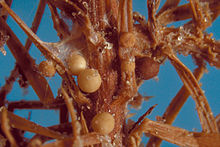
Botrytis cinerea is a necrotrophic fungus that affects many plant species, although its most notable hosts may be wine grapes. In viticulture, it is commonly known as "botrytis bunch rot"; in horticulture, it is usually called "grey mould" or "gray mold".

Texas root rot is a disease that is fairly common in Mexico and the southwestern United States resulting in sudden wilt and death of affected plants, usually during the warmer months. It is caused by a soil-borne fungus named Phymatotrichopsis omnivora that attacks the roots of susceptible plants. It was first discovered in 1888 by Pammel and later named by Duggar in 1916.
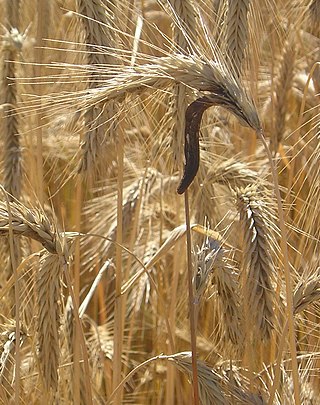
A sclerotium is a compact mass of hardened fungal mycelium containing food reserves. One role of sclerotia is to survive environmental extremes. In some higher fungi such as ergot, sclerotia become detached and remain dormant until favorable growth conditions return. Sclerotia initially were mistaken for individual organisms and described as separate species until Louis René Tulasne proved in 1853 that sclerotia are only a stage in the life cycle of some fungi. Further investigation showed that this stage appears in many fungi belonging to many diverse groups. Sclerotia are important in the understanding of the life cycle and reproduction of fungi, as a food source, as medicine, and in agricultural blight management.
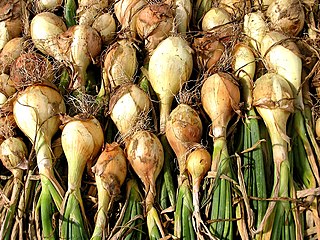
White onion or Allium cepa are a cultivar of dry onion which have a distinct light and mild flavour profile. Much like red onions, they have a high sugar and low sulphur content, and thus have a relatively short shelf life. White onions are used in a variety of dishes, such as those of Mexican and European origin. Their uses in dishes often relate to their mild nature, they are often included in dishes to provide a light, fresh and sour taste to dishes and are often added uncooked to dishes such as salads.

Rhizoctonia solani is a species of fungus in the order Cantharellales. Basidiocarps are thin, effused, and web-like, but the fungus is more typically encountered in its anamorphic state, as hyphae and sclerotia. The name Rhizoctonia solani is currently applied to a complex of related species that await further research. In its wide sense, Rhizoctonia solani is a facultative plant pathogen with a wide host range and worldwide distribution. It causes various plant diseases such as root rot, damping off, and wire stem. It can also form mycorrhizal associations with orchids.
Alternaria triticina is a fungal plant pathogen that causes leaf blight on wheat. A. triticina is responsible for the largest leaf blight issue in wheat and also causes disease in other major cereal grain crops. It was first identified in India in 1962 and still causes significant yield loss to wheat crops on the Indian subcontinent. The disease is caused by a fungal pathogen and causes necrotic leaf lesions and in severe cases shriveling of the leaves.

Macrophomina phaseolina is a Botryosphaeriaceae plant pathogen fungus that causes damping off, seedling blight, collar rot, stem rot, charcoal rot, basal stem rot, and root rot on many plant species.

Sclerotinia sclerotiorum is a plant pathogenic fungus and can cause a disease called white mold if conditions are conducive. S. sclerotiorum can also be known as cottony rot, watery soft rot, stem rot, drop, crown rot and blossom blight. A key characteristic of this pathogen is its ability to produce black resting structures known as sclerotia and white fuzzy growths of mycelium on the plant it infects. These sclerotia give rise to a fruiting body in the spring that produces spores in a sac which is why fungi in this class are called sac fungi (Ascomycota). This pathogen can occur on many continents and has a wide host range of plants. When S. sclerotiorum is onset in the field by favorable environmental conditions, losses can be great and control measures should be considered.

Ceratobasidium cornigerum is a species of fungus in the order Cantharellales. Basidiocarps are thin, spread on the substrate out like a film (effused) and web-like. An anamorphic state is frequently obtained when isolates are cultured. Ceratobasidium cornigerum is saprotrophic, but is also a facultative plant pathogen, causing a number of economically important crop diseases, and an orchid endomycorrhizal associate. The species is genetically diverse and is sometimes treated as a complex of closely related taxa. DNA research shows the species actually belongs within the genus Rhizoctonia.

Colletotrichum coccodes is a plant pathogen, which causes anthracnose on tomato and black dot disease of potato. Fungi survive on crop debris and disease emergence is favored by warm temperatures and wet weather.

The Corticiaceae are a family of fungi in the order Corticiales. The family formerly included almost all the corticioid fungi, whether they were related or not, and as such was highly artificial. In its current sense, however, the name Corticiaceae is restricted to a comparatively small group of corticioid genera within the Corticiales.

Ceratobasidium is a genus of fungi in the order Cantharellales. Basidiocarps are effused and the genus is sometimes grouped among the corticioid fungi, though species also retain features of the heterobasidiomycetes. Anamorphic forms were formerly referred to the genus Ceratorhiza, but this is now considered a synonym of Rhizoctonia. Ceratobasidium species, excluding the type, are also now considered synonymous with Rhizoctonia and some species have been transferred to the latter genus. Species are saprotrophic, but several are also facultative plant pathogens, causing a number of commercially important crop diseases. Some are also endomycorrhizal associates of orchids.
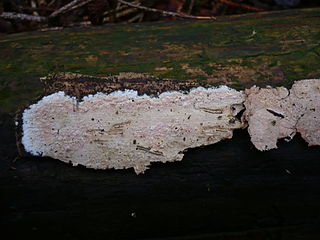
Amylocorticiales is an order of fungi in the class Agaricomycetes. The order was circumscribed in 2010 to contain mostly resupinate (crust-like) forms that have been referred to genera Anomoporia, Amyloathelia, Amylocorticiellum, Amylocorticium, Amyloxenasma, Anomoloma, Athelopsis, Ceraceomyces, Hypochniciellum, Leptosporomyces and Serpulomyces and the anomalous species, Athelia rolfsii, now classified in its own genus, Agroathelia.

Helicobasidium is a genus of fungi in the subdivision Pucciniomycotina. Basidiocarps are corticioid (patch-forming) and are typically violet to purple. Microscopically they have auricularioid basidia. Asexual anamorphs, formerly referred to the genus Thanatophytum, produce sclerotia. Conidia-bearing anamorphs are parasitic on rust fungi and are currently still referred to the genus Tuberculina.
Snow mold is a type of fungus and a turf disease that damages or kills grass after snow melts, typically in late winter. Its damage is usually concentrated in circles three to twelve inches in diameter, although yards may have many of these circles, sometimes to the point at which it becomes hard to differentiate between different circles. Snow mold comes in two varieties: pink or gray. While it can affect all types of grasses, Kentucky bluegrass and fescue lawns are least affected by snow mold.
Stromatinia cepivora is a fungus in the division Ascomycota. It is the teleomorph of Sclerotium cepivorum, the cause of white rot in onions, garlic, and leeks. The infective sclerotia remain viable in the soil for many years and are stimulated to germinate by the presence of a susceptible crop.

Collar rot is a symptomatically described disease that is usually caused by any one of various fungal and oomycete plant pathogens. It is present where the pathogen causes a lesion localized at or about the collet between the stem and the root. The lesions develop around the stem eventually forming a "collar". Observationally, collar rot grades into "basal stem rot", and with some pathogens is the first phase of "basal stem rot" often followed by "root rot". Collar rot is most often observed in seedings grown in infected soil. The pathogens that cause collar rot may be species or genera specific. But generalist pathogens such as Agroathelia rolfsii are known to attack over 200 different species. While bacteria caused collar rot is not common, trees infected with Fire blight may develop collar rot. Non-parasitic collar rot may be caused by winter damage.
A mycoparasite is an organism with the ability to parasitize fungi.
Black rot on orchids is caused by Pythium and Phytophthora species. Black rot targets a variety of orchids but Cattleya orchids are especially susceptible. Pythium ultimum and Phytophthora cactorum are known to cause black rot in orchids.
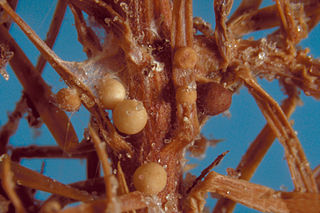
Agroathelia is a fungal genus currently consisting of one widespread and two other species. Agroathelia rolfsii, the type species, causes serious diseases of cultivated crops such as tomatoes, potatoes, peanuts, bell peppers, and sweet potatoes among many other hosts. It is better known under the names Sclerotium rolfsii or Athelia rolfsii.
